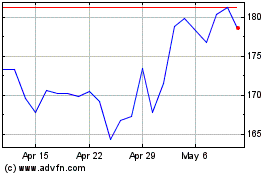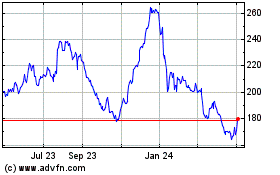The Strategic Costs of Boeing's Dash for Cash
April 28 2020 - 6:25AM
Dow Jones News
By Jon Sindreu
Whatever flight path Boeing finds through the Covid crisis, it
is unlikely to improve the U.S. aerospace giant's competitive
position versus European rival Airbus.
Alongside reporting first-quarter results on Wednesday, Boeing
is expected to give investors clarity on how it hopes to rebuild
its cash buffers and downsize its operations. The company probably
had about $15 billion in cash at the end of March, which could rise
to $24 billion by June as the company raises yet more debt,
according to FactSet's consensus of analyst estimates.
Even that might not cover Boeing's potential cash outflows if
travel restrictions last for longer than expected, especially given
that the ill-fated 737 MAX is still awaiting recertification. So
one closely watched question is whether Chief Executive David
Calhoun will tap the federal government's $60 billion aid package
for the aerospace industry. He was previously reluctant to accept
public aid on the basis that it could come with costly strings
attached.
In reality, though, any decisions he takes to keep the business
airborne will necessarily come at the expense of its longer-term
strategy.
Boeing announced last weekend that it was pulling out of its
agreement to buy a majority stake in Embraer's commercial-jet
division for $4.2 billion. The Brazilian aerospace manufacturer is
demanding compensation, whereas Boeing is blaming Embraer for
failing to meet the required conditions.
Boeing isn't linking the move to the current crisis, but the
reality is that it needs the money. In Monday's annual general
meeting of shareholders, Mr. Calhoun said he expects air traffic to
remain depressed for between two and three years. While investors
will likely have to wait until Wednesday to hear how far the
company will cut plane-production rates, airlines are already
deferring and canceling orders.
The deal's demise is an immediate problem for loss-making
Embraer, which will struggle to stay afloat. Yet the impact on the
Chicago-based company could eventually be just as significant.
Boeing needed Embraer's state-of-the-art E-Jet E2 family to
compete in the market for commercial planes in the 90-to-150 seat
range. Airbus has started to reinvigorate this once-sluggish
segment since its 2017 purchase of Bombardier's CSeries -- now
renamed the A220. A post-coronavirus scenario of record-low fuel
prices and sluggish demand will probably make such jets more
popular, as filling a 737 or an A320 becomes harder.
For all the criticism leveled at Boeing since the 737 MAX
debacle, its strategic calls in recent decades have often been spot
on. The 787 Dreamliner was a visionary bet on leaner planes at a
time when Airbus was wasting resources on the behemoth, four-engine
A380. Even the MAX was an efficient temporary response to the
challenge posed by the massively popular Airbus A320.
What Mr. Calhoun had to fix was the company's excessive focus on
cost-cutting, which led to botched execution. The 787 was delayed
for years, giving Airbus time to come up with a competitor. And
Boeing's failure to quickly green-light a midsize jet has handed
the Airbus A321 a big lead in a promising market segment.
In addition to the E-Jet E2, the Embraer purchase would have
given Boeing more engineering nous. Now, all the company's
longer-range projects have likely been scrapped, or will at least
be massively delayed in favor of rebuilding the balance sheet. For
the foreseeable future, there is no challenge to Airbus's supremacy
in all segments apart from wide-bodies -- the one most affected by
the pandemic.
Both plane makers will have a rough time getting through what is
likely to be the biggest crisis in aviation history. For Boeing,
though, the lost time could come at a higher cost.
Write to Jon Sindreu at jon.sindreu@wsj.com
(END) Dow Jones Newswires
April 28, 2020 06:10 ET (10:10 GMT)
Copyright (c) 2020 Dow Jones & Company, Inc.
Boeing (NYSE:BA)
Historical Stock Chart
From Jun 2024 to Jul 2024

Boeing (NYSE:BA)
Historical Stock Chart
From Jul 2023 to Jul 2024
